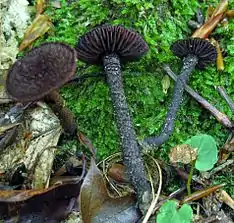Inocybe tahquamenonensis
Inocybe tahquamenonensis is an inedible species of agaric fungus in the family Inocybaceae.[1] Found in the United States, it was formally described in 1954 by mycologist Daniel E. Stuntz.[2] The fruit bodies have bell-shaped to convex to flattened caps measuring 1.2–3 cm (0.5–1.2 in) in diameter. Its color is dark purplish brown to reddish- or blackish-brown, with reddish-purple flesh. The gills are attached to the stipe and are somewhat distantly spaced. They are initially reddish brown before turning to chocolate brown, sometimes developing whitish edges. The spore print is brown; spores measure 6–8.5 by 5–6 µm. Fruit bodies grow singly, scattered, or in group under deciduous trees.[3]
| Inocybe tahquamenonensis | |
|---|---|
 | |
| Scientific classification | |
| Kingdom: | |
| Division: | |
| Class: | |
| Order: | |
| Family: | |
| Genus: | |
| Species: | I. tahquamenonensis |
| Binomial name | |
| Inocybe tahquamenonensis D.E.Stuntz (1954) | |
See also
References
- Phillips, Roger (2010). Mushrooms and Other Fungi of North America. Buffalo, NY: Firefly Books. p. 212. ISBN 978-1-55407-651-2.
- Stuntz DE (1954). "Studies on the genus Inocybe. II. New and note worthy species from Michigan". Papers of the Michigan Academy of Sciences. 39: 53–84.
- Bessette A, Bessette AR, Fischer DW (1997). Mushrooms of Northeastern North America. Syracuse, New York: Syracuse University Press. p. 152. ISBN 978-0815603887.
External links
This article is issued from Wikipedia. The text is licensed under Creative Commons - Attribution - Sharealike. Additional terms may apply for the media files.